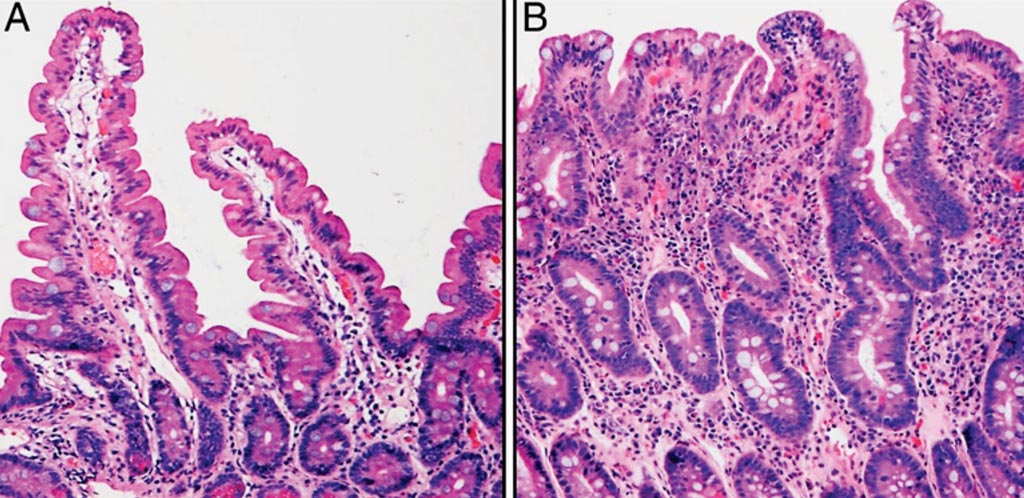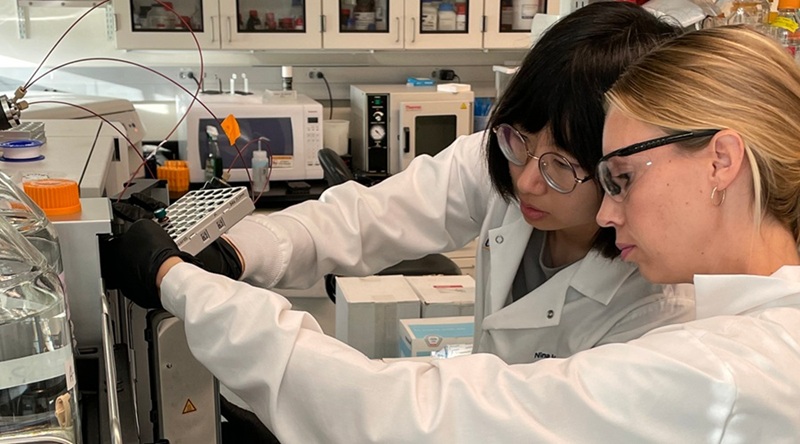Biomarker Found for Celiac Patients on Gluten-Free Diet
|
By LabMedica International staff writers Posted on 19 Jun 2019 |

Representative histologic features of the small intestine. In the normal duodenal biopsy (A), the villi are elongated and the crypts relatively short. This is in contrast to the small intestinal tissue affected by celiac disease (B), which demonstrates marked villus blunting and crypt hyperplasia. (Photo courtesy of Tracy R. Ediger MD, and Ivor D. Hill, MD ChB).
Celiac disease is a complex condition, routinely treated by means of a strict gluten-free diet (GFD). One of the diagnostic challenges of this disease is that patients need to be consuming gluten so that a correct diagnosis by means of endoscopy can be made.
Celiac disease (CeD) is an immune-mediated enteropathy with a strong genetic component, where alleles encoding Human Leukocyte Antigen (HLA)-DQ2 and -DQ8 molecules account for 40% of disease heritability. A genetic, constitutive biomarker present also when the disease-triggering insult is absent would be extremely useful for the diagnosis this conditions.
Scientists associated with the University of the Basque Country (Leioa, Spain) hypothesized that merging different levels of genomic information through Mendelian Randomization (MR) could help discover genetic biomarkers useful for CeD diagnosis. MR was performed using public databases (9,451 cases and 16,434 controls) of expression quantitative trait loci (eQTL) and methylation QTL (mQTL) as exposures, and the largest CeD genome-wide association study (GWAS) conducted to date as the outcome, in order to identify potential causal genes.
The scientists identified UBE2L3, an ubiquitin ligase located in a CeD-associated region. They interrogated the expression of UBE2L3 in an independent dataset of peripheral blood mononuclear cells (PBMCs) and found that its expression is altered in CeD patients on GFD when compared to non-celiac controls. The relative expression of UBE2L3 isoforms predicts CeD with 100% specificity and sensitivity and could be used as a diagnostic marker, especially in the absence of gluten consumption.
The authors concluded that the relative expression of the isoforms of the UBE2L3 gene in the blood makes it possible to distinguish with 100% sensitivity and specificity celiac patients on a gluten-free diet. The approach used could be applicable to other diseases where diagnosis of asymptomatic patients can be complicated. The study was published on May 29, 2019, in the journal Human Molecular Genetics.
Related Links:
University of the Basque Country
Celiac disease (CeD) is an immune-mediated enteropathy with a strong genetic component, where alleles encoding Human Leukocyte Antigen (HLA)-DQ2 and -DQ8 molecules account for 40% of disease heritability. A genetic, constitutive biomarker present also when the disease-triggering insult is absent would be extremely useful for the diagnosis this conditions.
Scientists associated with the University of the Basque Country (Leioa, Spain) hypothesized that merging different levels of genomic information through Mendelian Randomization (MR) could help discover genetic biomarkers useful for CeD diagnosis. MR was performed using public databases (9,451 cases and 16,434 controls) of expression quantitative trait loci (eQTL) and methylation QTL (mQTL) as exposures, and the largest CeD genome-wide association study (GWAS) conducted to date as the outcome, in order to identify potential causal genes.
The scientists identified UBE2L3, an ubiquitin ligase located in a CeD-associated region. They interrogated the expression of UBE2L3 in an independent dataset of peripheral blood mononuclear cells (PBMCs) and found that its expression is altered in CeD patients on GFD when compared to non-celiac controls. The relative expression of UBE2L3 isoforms predicts CeD with 100% specificity and sensitivity and could be used as a diagnostic marker, especially in the absence of gluten consumption.
The authors concluded that the relative expression of the isoforms of the UBE2L3 gene in the blood makes it possible to distinguish with 100% sensitivity and specificity celiac patients on a gluten-free diet. The approach used could be applicable to other diseases where diagnosis of asymptomatic patients can be complicated. The study was published on May 29, 2019, in the journal Human Molecular Genetics.
Related Links:
University of the Basque Country
Latest Molecular Diagnostics News
- New 15-Minute Hepatitis C Test Paves Way for Same-Day Treatment
- Ovarian Cancer Assay Outperforms Traditional Tests in Early Disease Detection
- Ultrasensitive Method Detects Low-Frequency Cancer Mutations
- Blood Test Enables Non-Invasive Endometriosis Detection
- New Blood Biomarkers Help Diagnose Pregnancy-Linked Liver Complication
- Simple Urine Test to Revolutionize Bladder Cancer Diagnosis and Treatment
- Blood Test to Enable Earlier and Simpler Detection of Liver Fibrosis
- Genetic Marker to Help Children with T-Cell Leukemia Avoid Unnecessary Chemotherapy
- Four-Gene Blood Test Rules Out Bacterial Lung Infection
- New PCR Test Improves Diagnostic Accuracy of Bacterial Vaginosis and Candida Vaginitis
- New Serum Marker-Editing Strategy to Improve Diagnosis of Neurological Diseases
- World’s First Genetic Type 1 Diabetes Risk Test Enables Early Detection
- Blood Test to Help Low-Risk Gastric Cancer Patients Avoid Unnecessary Surgery
- First-Of-Its-Kind Automated System Speeds Myeloma Diagnosis
- Blood Protein Profiles Predict Mortality Risk for Earlier Medical Intervention
- First Of Its Kind Blood Test Detects Gastric Cancer in Asymptomatic Patients
Channels
Clinical Chemistry
view channel
Online Tool Detects Drug Exposure Directly from Patient Samples
Doctors often rely on patient interviews and medical records to determine what medications a person has taken, but this information is frequently incomplete. People may forget drugs they used, take over-the-counter... Read more
Chemical Imaging Probe Could Track and Treat Prostate Cancer
Prostate cancer remains a leading cause of illness and death among men, with many patients eventually developing resistance to standard hormone-blocking therapies. These drugs often lose effectiveness... Read moreHematology
view channel
MRD Tests Could Predict Survival in Leukemia Patients
Acute myeloid leukemia is an aggressive blood cancer that disrupts normal blood cell production and often relapses even after intensive treatment. Clinicians currently lack early, reliable markers to predict... Read more
Platelet Activity Blood Test in Middle Age Could Identify Early Alzheimer’s Risk
Early detection of Alzheimer’s disease remains one of the biggest unmet needs in neurology, particularly because the biological changes underlying the disorder begin decades before memory symptoms appear.... Read more
Microvesicles Measurement Could Detect Vascular Injury in Sickle Cell Disease Patients
Assessing disease severity in sickle cell disease (SCD) remains challenging, especially when trying to predict hemolysis, vascular injury, and risk of complications such as vaso-occlusive crises.... Read more
ADLM’s New Coagulation Testing Guidance to Improve Care for Patients on Blood Thinners
Direct oral anticoagulants (DOACs) are one of the most common types of blood thinners. Patients take them to prevent a host of complications that could arise from blood clotting, including stroke, deep... Read moreImmunology
view channel
Routine Blood Test Can Predict Who Benefits Most from CAR T-Cell Therapy
CAR T-cell therapy has transformed treatment for patients with relapsed or treatment-resistant non-Hodgkin lymphoma, but many patients eventually relapse despite an initial response. Clinicians currently... Read more
New Test Distinguishes Vaccine-Induced False Positives from Active HIV Infection
Since HIV was identified in 1983, more than 91 million people have contracted the virus, and over 44 million have died from related causes. Today, nearly 40 million individuals worldwide live with HIV-1,... Read more
Gene Signature Test Predicts Response to Key Breast Cancer Treatment
DK4/6 inhibitors paired with hormone therapy have become a cornerstone treatment for advanced HR+/HER2– breast cancer, slowing tumor growth by blocking key proteins that drive cell division.... Read more
Chip Captures Cancer Cells from Blood to Help Select Right Breast Cancer Treatment
Ductal carcinoma in situ (DCIS) accounts for about a quarter of all breast cancer cases and generally carries a good prognosis. This non-invasive form of the disease may or may not become life-threatening.... Read moreMicrobiology
view channel
Blood-Based Diagnostic Method Could Identify Pediatric LRTIs
Lower-respiratory tract infections (LRTIs) are a leading cause of illness and death worldwide, and pneumonia is the leading infectious cause of death in children under five, claiming the lives of over... Read more
Rapid Diagnostic Test Matches Gold Standard for Sepsis Detection
Sepsis kills 11 million people worldwide every year and generates massive healthcare costs. In the USA and Europe alone, sepsis accounts for USD 100 billion in annual hospitalization expenses.... Read moreRapid POC Tuberculosis Test Provides Results Within 15 Minutes
Tuberculosis remains one of the world’s deadliest infectious diseases, and reducing new cases depends on identifying individuals with latent infection before it progresses. Current diagnostic tools often... Read more
Rapid Assay Identifies Bloodstream Infection Pathogens Directly from Patient Samples
Bloodstream infections in sepsis progress quickly and demand rapid, precise diagnosis. Current blood-culture methods often take one to five days to identify the pathogen, leaving clinicians to treat blindly... Read morePathology
view channel
Rapid Low-Cost Tests Can Prevent Child Deaths from Contaminated Medicinal Syrups
Medicinal syrups contaminated with toxic chemicals have caused the deaths of hundreds of children worldwide, exposing a critical gap in how these products are tested before reaching patients.... Read more
Tumor Signals in Saliva and Blood Enable Non-Invasive Monitoring of Head and Neck Cancer
Head and neck cancers are among the most aggressive malignancies worldwide, with nearly 900,000 new cases diagnosed each year. Monitoring these cancers for recurrence or relapse typically relies on tissue... Read more
Common Health Issues Can Influence New Blood Tests for Alzheimer’s Disease
Blood-based tests for Alzheimer’s disease are transforming diagnosis by offering a simpler alternative to spinal taps and brain imaging. However, many people evaluated at memory clinics also live with... Read more
Blood Test Formula Identifies Chronic Liver Disease Patients with Higher Cancer Risk
Chronic liver disease affects millions worldwide and can progress silently to hepatocellular carcinoma (HCC), one of the deadliest cancers globally. While surveillance guidelines exist for patients with... Read moreTechnology
view channel
Machine Learning Models Diagnose ALS Earlier Through Blood Biomarkers
Amyotrophic lateral sclerosis (ALS) is a rapidly progressive neurodegenerative disease that is notoriously difficult to diagnose in its early stages. Early symptoms often overlap with other neurological... Read more
Artificial Intelligence Model Could Accelerate Rare Disease Diagnosis
Identifying which genetic variants actually cause disease remains one of the biggest challenges in genomic medicine. Each person carries tens of thousands of DNA changes, yet only a few meaningfully alter... Read moreIndustry
view channel
Abbott Acquires Cancer-Screening Company Exact Sciences
Abbott (Abbott Park, IL, USA) has entered into a definitive agreement to acquire Exact Sciences (Madison, WI, USA), enabling it to enter and lead in fast-growing cancer diagnostics segments.... Read more
















